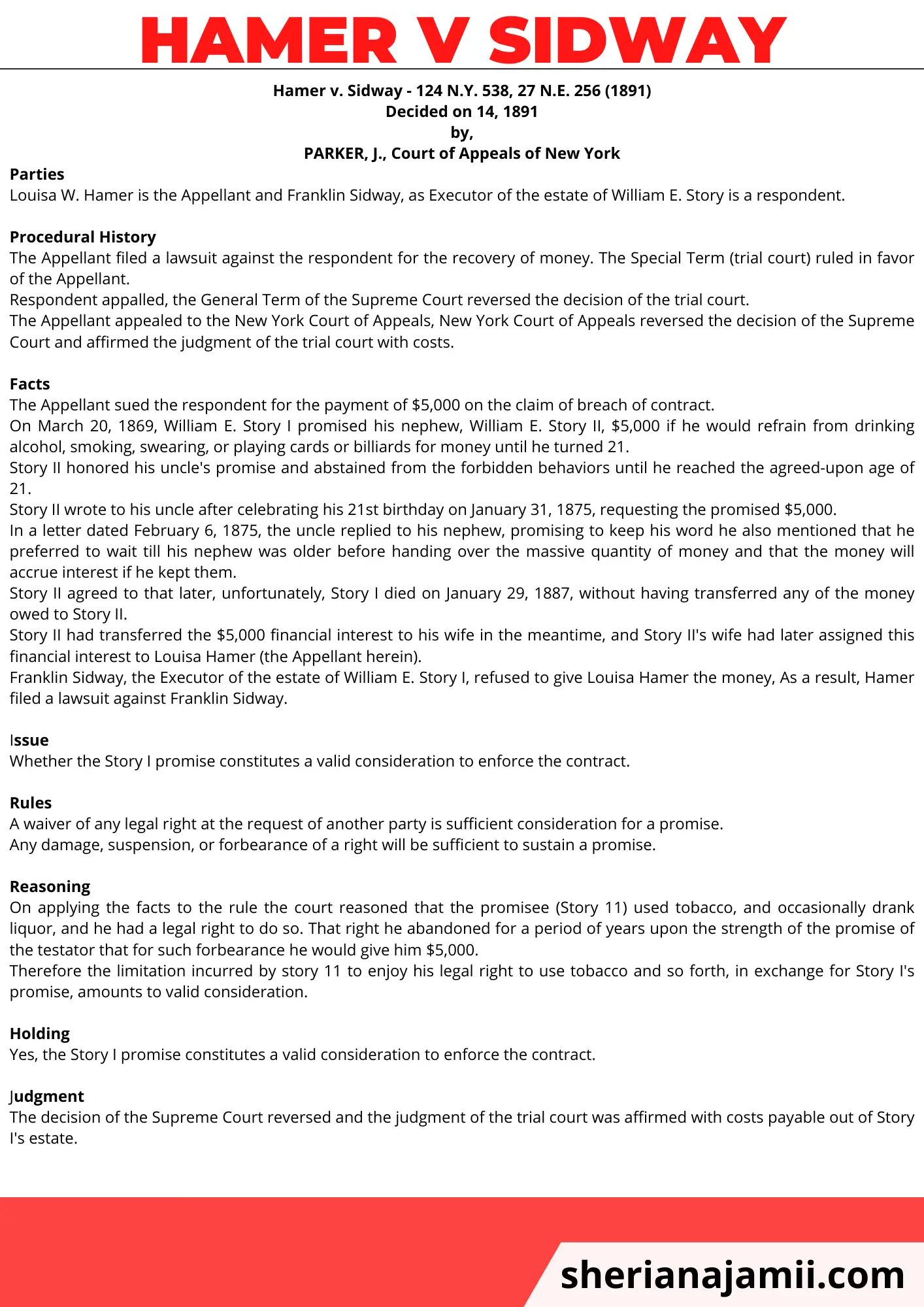Here you will see the Hamer v Sidway case brief.
The Hamer v. Sidway case is significant in American contract law.
Hamer v. Sidway established the principle that the voluntary promises of future benefit constitute a valid consideration.
Here I will share with you the Hamer v Sidway case brief to help you understand everything you need to know about the hamer v sidway case in a simple and accurate way.
Interested in learning how to write your own case brief? learn here or you may check these case brief templates.
let’s get started
Jump to section
hamer v sidway case brief
Hamer v. Sidway – 124 N.Y. 538, 27 N.E. 256 (1891)
Decided on 14, 1891
by,
PARKER, J., Court of Appeals of New York
Parties
Louisa W. Hamer is the Appellant and Franklin Sidway, as Executor of the estate of William E. Story is a respondent.
Procedural History
The Appellant filed a lawsuit against the respondent for the recovery of money. The Special Term (trial court) ruled in favor of the Appellant.
Respondent appalled, the General Term of the Supreme Court reversed the decision of the trial court.
The Appellant appealed to the New York Court of Appeals, New York Court of Appeals reversed the decision of the Supreme Court and affirmed the judgment of the trial court with costs.
Facts
The Appellant sued the respondent for the payment of $5,000 on the claim of breach of contract.
On March 20, 1869, William E. Story I promised his nephew, William E. Story II, $5,000 if he would refrain from drinking alcohol, smoking, swearing, or playing cards or billiards for money until he turned 21.
Story II honored his uncle’s promise and abstained from the forbidden behaviors until he reached the agreed-upon age of 21.
Story II wrote to his uncle after celebrating his 21st birthday on January 31, 1875, requesting the promised $5,000.
In a letter dated February 6, 1875, the uncle replied to his nephew, promising to keep his word he also mentioned that he preferred to wait till his nephew was older before handing over the massive quantity of money and that the money will accrue interest if he kept them.
Story II agreed to that later, unfortunately, Story I died on January 29, 1887, without having transferred any of the money owed to Story II.
Story II had transferred the $5,000 financial interest to his wife in the meantime, and Story II’s wife had later assigned this financial interest to Louisa Hamer (the Appellant herein).
Franklin Sidway, the Executor of the estate of William E. Story I, refused to give Louisa Hamer the money, As a result, Hamer filed a lawsuit against Franklin Sidway.
Issue
Whether the Story I promise constitutes a valid consideration to enforce the contract.
Rules
A waiver of any legal right at the request of another party is sufficient consideration for a promise.
Any damage, suspension, or forbearance of a right will be sufficient to sustain a promise.
Reasoning
On applying the facts to the rule the court reasoned that the promisee (Story 11) used tobacco, and occasionally drank liquor, and he had a legal right to do so. That right he abandoned for a period of years upon the strength of the promise of the testator that for such forbearance he would give him $5,000.
Therefore the limitation incurred by story 11 to enjoy his legal right to use tobacco and so forth, in exchange for Story I‘s promise, amounts to valid consideration.
Holding
Yes, the Story I promise constitutes a valid consideration to enforce the contract.
Judgment
The decision of the Supreme Court reversed and the judgment of the trial court was affirmed with costs payable out of Story I’s estate.
Read the full Judgment here
Other case briefs to read
- Marbury versus Madison case brief
- Lucy v Zehmer case brief
- Pennoyer v Neff case brief
- Pierson v Post case brief
- Hawkins v Mcgee case brief
- Tinker v des Moines case brief
- Hadley v Baxendale case brief
- Duncan v Louisiana case brief
- Garrett v Dailey case brief
- Brown v Board of education case brief
- Griswold v Connecticut case brief
- Katz v United States case brief
- Riley v California case brief | United States v. Wurie
- Leonard v Pepsico case brief
- Wickard v Filburn case brief
- District of Columbia v. Heller case brief
- Gonzales v Raich case brief
- Shelley v Kraemer case brief




